AI and AR in the Beauty Industry

The increasing popularity of AI and AR in the beauty industry marks the dawn of a lucrative new era in ecommerce!
If you’re not familiar with Artificial Intelligence (AI),Augmented Reality(AR) or the difference between the two, you’re not alone. In our fast-paced digital society, AI and AR in the beauty industry comes up frequently, but many people don’t have a solid understanding of how either technology actually works.
AI is a computer’s ability to think and learn. Every time you Google a question or browse your Netflix recommendations, you are interacting with AI. Intelligent algorithms sift through massive amounts of data and identify patterns in order to make decisions. After completing a round of data processing, AI systems analyze their own performance, allowing them to “get smarter” over time.
AR is the integration of digital information with the real world to create an enhanced physical environment. Snapchat is an excellent example of how AI and AR interact to seamlessly combine digital and physical elements. The ubiquitous selfie app uses AI to detect your features which then allows AR to impose a realistic filter on your face.
Now that we’ve covered the basics, let’s talk about the impact of AI and AR in the beauty industry.
During the pandemic, the popularity of online shopping skyrocketed, as did consumers’ desire for a personalized retail experience from the safety of their homes. Beauty brands like Tarte Cosmetics, Aveda, Estée Lauder, L’Oreal, Covergirl and many more capitalized on growing digital demand by harnessing the joint powers of AI and AR. Using these technologies, companies began offering customers an individualized yet totally remote shopping experience in the form of virtual try-on features. The concept was an enormous success.
After launching a virtual try-on feature that allows consumers to experiment with different makeup shades, Tarte Cosmetics saw a whopping 200% increase in sales. The introduction of AI and AR-powered software also led to a decrease in customer service calls since engaging with products online boosted consumers’ confidence in their purchases.
In a similar fashion, Aveda’s introduction of a highly realistic hair color try-on tool dramatically increased website traffic to the brand’s salon locator and drove a 112% spike in time spent on the company website. And the statistics just keep growing!
According to Estée Lauder’s Vice President of Digital Technology and Engineering Chris Aidan, the cosmetic brand’s contactless try-before-you-buy feature has done wonders for customer satisfaction. “Using our Virtual Try On Augmented Reality Platform, consumers are able to see the exact tone [of makeup] and pick products they know are going to look good,” he said.
The technology is also used to make helpful predictions in other areas of the beauty biz. Sowmya Gottipati, Estée Lauder’s Vice President of Global Supply Chain, reported that after switching to an AI application for their supply and demand planning, the brand saw a 30% increase in forecasting accuracy. Higher accuracy means higher profit margins, so you get the picture: CEO’s everywhere are thrilled.
Of course, there are two sides to every story, and this one is no exception. Despite the astronomical business benefits, the rapid growth of AI and AR in the beauty industry and beyond raises concerns about privacy and the abuse of personal data. In the words of tech magnate Elon Musk, “The pace of progress in artificial intelligence…is incredibly fast. Unless you have direct exposure…you have no idea how fast—it is growing at a pace close to exponential. The risk of something seriously dangerous happening is in the five-year time frame. Ten years at most.”
Though not exactly a positive forecast, we will have to see if AI and AR in the beauty industry continues to grow! But in the meantime, rejoice, shoppers: finding the perfect shade of makeup from a distance has never been easier.